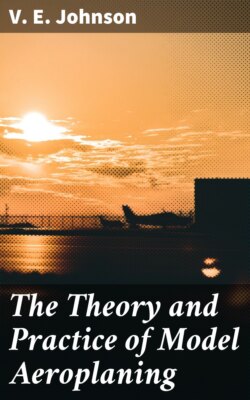Читать книгу The Theory and Practice of Model Aeroplaning - V. E. Johnson - Страница 6
INTRODUCTION.
Оглавление§ 1. Model Aeroplanes are primarily divided into two classes: first, models intended before all else to be ones that shall fly; secondly, models, using the word in its proper sense of full-sized machines. Herein model aeroplanes differ from model yachts and model locomotives. An extremely small model locomotive built to scale will still work, just as a very small yacht built to scale will sail; but when you try to build a scale model of an "Antoinette" monoplane, including engine, it cannot be made to fly unless the scale be a very large one. If, for instance, you endeavoured to make a 1/10 scale model, your model petrol motor would be compelled to have eight cylinders, each 0·52 bore, and your magneto of such size as easily to pass through a ring half an inch in diameter. Such a model could not possibly work.[1]
Note.—Readers will find in the "Model Engineer" of June 16, 1910, some really very fine working drawings of a prize-winning Antoinette monoplane model.
§ 2. Again, although the motor constitutes the chief, it is by no means the sole difficulty in scale model aeroplane building. To reproduce to scale at scale weight, or indeed anything approaching it, all the necessary—in the case of a full-sized machine—framework is not possible in a less than 1/5 scale.
§ 3. Special difficulties occur in the case of any prototype taken. For instance, in the case of model Blériots it is extremely difficult to get the centre of gravity sufficiently forward.
§ 4. Scale models of actual flying machines that will fly mean models at least 10 or 12 feet across, and every other dimension in like proportion; and it must always be carefully borne in mind that the smaller the scale the greater the difficulties, but not in the same proportion—it would not be twice as difficult to build a ¼-in. scale model as a ½-in., but four, five or six times as difficult.
§ 5. Now, the first requirement of a model aeroplane, or flying machine, is that it shall FLY.
As will be seen later on—unless the machine be of large size, 10 feet and more spread—the only motor at our disposal is the motor of twisted rubber strands, and this to be efficient requires to be long, and is of practically uniform weight throughout; this alone alters the entire distribution of weight on the machine and makes:
§ 6. "Model Aeroplaning an Art in itself," and as such we propose to consider it in the following pages.
We have said that the first requisite of a model aeroplane is that it shall fly, but there is no necessity, nor is it indeed always to be desired, that this should be its only one, unless it be built with the express purpose of obtaining a record length of flight. For ordinary flights and scientific study what is required is a machine in which minute detail is of secondary importance, but which does along its main lines "approximate to the real thing."
§ 7. Simplicity should be the first thing aimed at—simplicity means efficiency, it means it in full-sized machines, still more does it mean it in models—and this very question of simplicity brings us to that most important question of all, namely, the question of weight.
